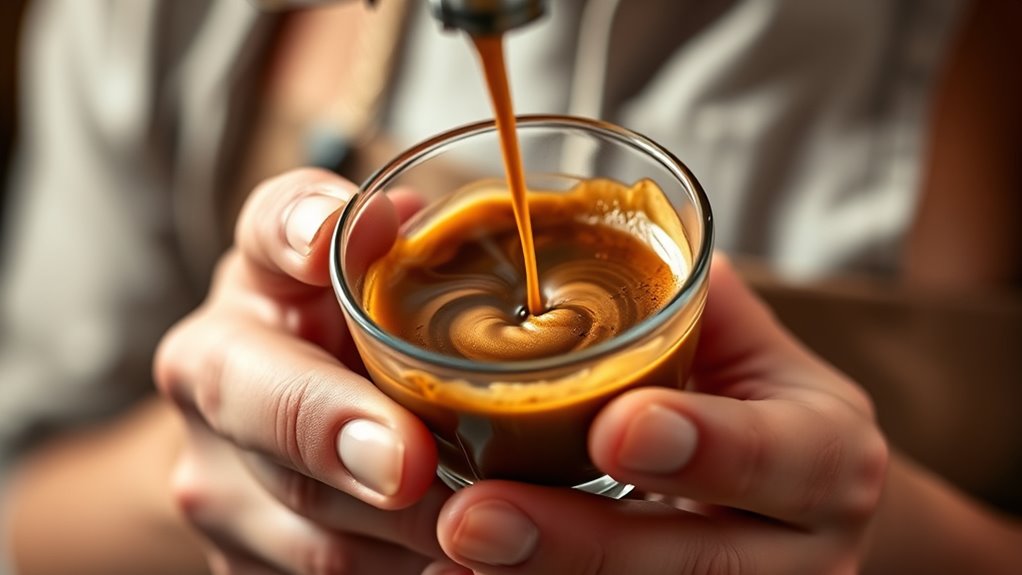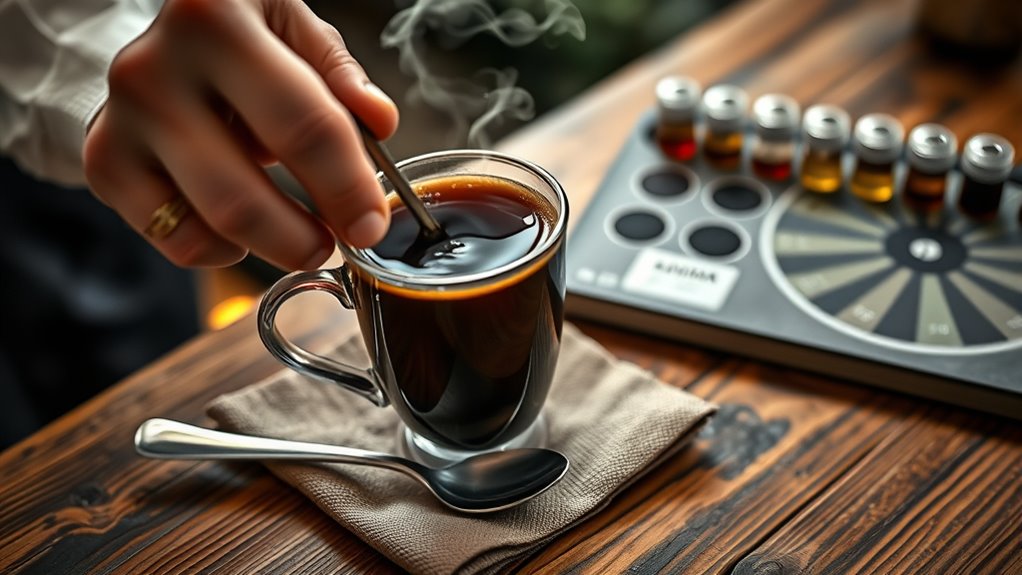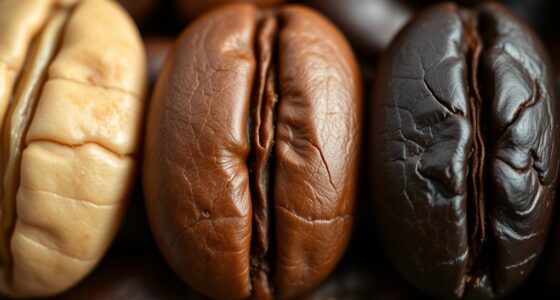The art of coffee sensory evaluation involves systematically tasting and smelling to identify a coffee’s unique flavors, aromas, and textures. You’ll learn to develop your sensory skills, differentiate nuanced notes, and understand the role of aroma compounds and flavor profiles. Using standardized cupping methods and tools like flavor wheels helps guarantee consistency and precision. Mastering these techniques deepens your appreciation and improves your ability to communicate about coffee quality — explore more to refine your palate further.
Key Takeaways
- Coffee sensory evaluation involves systematic tasting to identify aroma, flavor, body, and aftertaste nuances.
- Developing sensory skills enhances the ability to distinguish and describe complex coffee profiles accurately.
- Standardized cupping methods ensure consistent, objective assessments across different coffees.
- Tools like flavor wheels link sensory perceptions to chemical compounds, improving communication and understanding.
- Mastering sensory evaluation improves quality control, defect detection, and appreciation of coffee’s complexity.

Understanding the art of coffee sensory evaluation is essential for anyone interested in appraising coffee quality. Whether you’re a barista, roaster, or coffee enthusiast, mastering this skill allows you to recognize the nuances that make each cup unique. Sensory evaluation involves systematically analyzing the coffee’s aroma, flavor notes, body, and aftertaste to gauge its overall quality.
Mastering coffee sensory evaluation unlocks the nuances that make each cup uniquely exceptional.
This process often starts with cupping, a standardized method that guarantees consistency across tastings. During cupping, you follow precise steps—breaking the crust, smelling the grounds, tasting the brew—and score each attribute to maintain objectivity.
Developing your sensory skills is fundamental. It requires practice in smelling, tasting, and touching to identify specific flavor notes and subtle nuances. Over time, you’ll learn to distinguish fruity from floral aromas, identify hints of chocolate or spice, and recognize the coffee’s body and aftertaste.
Using tools like the flavor wheel helps categorize these sensory experiences, making it easier to communicate what you perceive and understand the complexity behind specialty coffee. As you refine your skills, you’ll find it easier to describe coffees accurately and appreciate their unique profiles.
Sensory evaluation also draws on knowledge of chemical compounds that influence coffee’s profile. Aromas are often linked to volatile aromatic compounds, while flavors can be affected by organic acids, sugars, and other organic molecules.
Understanding these chemical influences helps clarify why some coffees taste bright and fruity, while others are rich and chocolatey. This scientific insight enhances your tasting experience, allowing you to connect sensory perceptions with their underlying causes.
In addition to personal enjoyment, mastering sensory evaluation plays a key role in quality control. It guarantees consistency in the coffee you produce or serve, helping to identify defects or off-flavors early.
For professionals working with specialty coffee, it fosters better communication among team members, as everyone can articulate sensory observations more precisely. Ultimately, developing your sensory skills deepens your appreciation of coffee’s complexity, transforming a simple beverage into an art form.
Engaging in sensory evaluation also benefits from understanding how digital distractions can impact focus and perception during tasting sessions.
Frequently Asked Questions
What Is the Sensory Evaluation of Coffee?
Sensory evaluation of coffee involves systematically tasting and analyzing its aroma, flavor, mouthfeel, and appearance. You assess both dry and wet grounds to identify specific notes and qualities, following standardized methods like the SCA cupping protocol.
This process helps you quantify subjective experiences, ensuring consistency and quality control across different batches. By focusing on attributes like aroma, acidity, sweetness, and aftertaste, you gain a deeper understanding of the coffee’s unique profile.
What Is the Sensory Experience of Coffee?
The sensory experience of coffee involves you perceiving its aroma, flavor, mouthfeel, appearance, and aftertaste through your senses.
You notice the complex aromas from volatile compounds, the taste from organic acids and roasted flavors, and the texture ranging from light to creamy.
Your sight, smell, taste, and touch all work together to create a vivid, multi-layered impression of coffee’s overall quality and character.
What Are the 5 Senses of Coffee?
When you evaluate coffee, you use all five senses. You see the roast color, clarity, and any defects.
You smell the aroma, detecting floral, fruity, or nutty notes.
You taste to identify sweetness, bitterness, and acidity.
You feel the mouthfeel, noticing the body and texture.
Finally, you might hear the crackling sounds during roasting that influence flavor.
Engaging all senses helps you truly appreciate coffee’s complexity.
What Is the Art of Coffee Cupping?
You’re exploring coffee cupping, a precise method to assess coffee’s aroma, flavor, body, and aftertaste. You measure, grind, and steep fresh roasted beans, then smell the dry and wet grounds.
You break the crust and slurp to aerate the coffee, tasting systematically. This process helps you compare different beans and roast levels, ensuring quality and guiding your purchasing decisions while developing a deeper understanding of coffee’s sensory qualities.
Conclusion
By honing your sensory skills, you’ll deepen your appreciation for coffee’s nuances. Tasting mindfully helps you identify flavors, aromas, and textures that make each cup unique. With practice, you’ll trust your palate more and make better choices, whether brewing at home or selecting beans. Remember, coffee tasting is a journey—embrace the experience, stay curious, and enjoy every sip. The art of coffee sensory evaluation is yours to master, one cup at a time.









